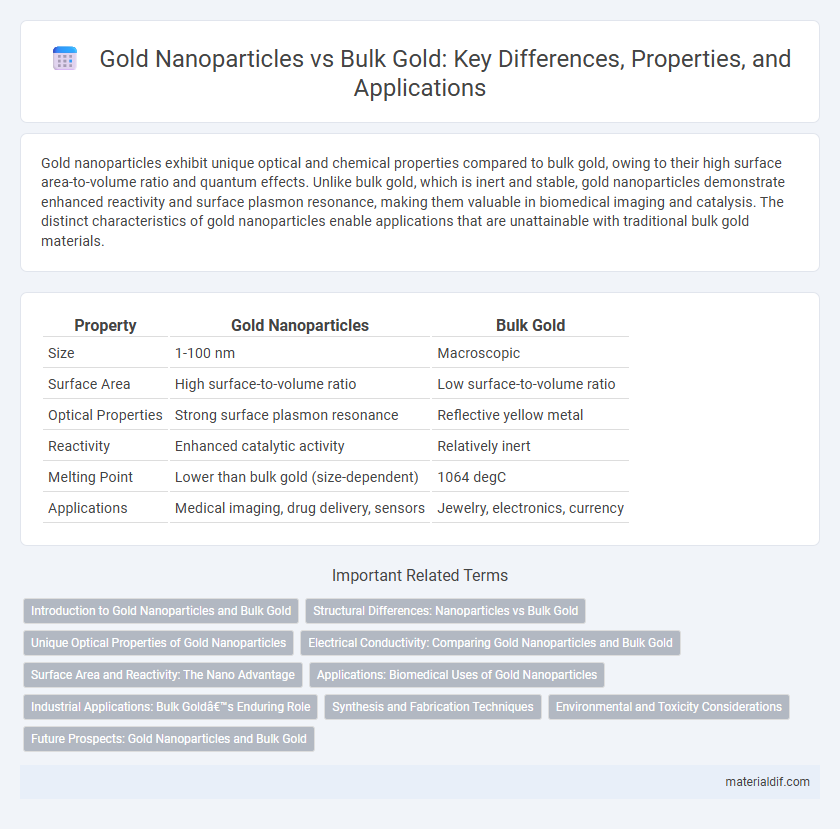Gold nanoparticles exhibit unique optical and chemical properties compared to bulk gold, owing to their high surface area-to-volume ratio and quantum effects. Unlike bulk gold, which is inert and stable, gold nanoparticles demonstrate enhanced reactivity and surface plasmon resonance, making them valuable in biomedical imaging and catalysis. The distinct characteristics of gold nanoparticles enable applications that are unattainable with traditional bulk gold materials.
Table of Comparison
| Property | Gold Nanoparticles | Bulk Gold |
|---|---|---|
| Size | 1-100 nm | Macroscopic |
| Surface Area | High surface-to-volume ratio | Low surface-to-volume ratio |
| Optical Properties | Strong surface plasmon resonance | Reflective yellow metal |
| Reactivity | Enhanced catalytic activity | Relatively inert |
| Melting Point | Lower than bulk gold (size-dependent) | 1064 degC |
| Applications | Medical imaging, drug delivery, sensors | Jewelry, electronics, currency |
Introduction to Gold Nanoparticles and Bulk Gold
Gold nanoparticles exhibit unique optical, electrical, and chemical properties due to their nanoscale size, significantly different from bulk gold, which is known for its high density, malleability, and excellent conductivity. The surface plasmon resonance effect in gold nanoparticles enables advanced applications in medical imaging, drug delivery, and catalysis. Bulk gold remains essential in traditional applications such as jewelry, electronics, and currency due to its stability and inertness.
Structural Differences: Nanoparticles vs Bulk Gold
Gold nanoparticles exhibit a high surface-to-volume ratio and possess unique crystallographic structures with numerous surface atoms, unlike bulk gold, which has a well-ordered face-centered cubic lattice extending uniformly. The atomic arrangement in nanoparticles leads to quantum size effects and increased surface energy, resulting in distinct mechanical and chemical properties compared to the stable, densely packed atomic structure of bulk gold. These structural differences fundamentally influence the reactivity, optical properties, and catalytic behavior of gold at the nanoscale versus its bulk counterpart.
Unique Optical Properties of Gold Nanoparticles
Gold nanoparticles exhibit unique optical properties compared to bulk gold due to surface plasmon resonance, which causes strong absorption and scattering of light at specific wavelengths. These properties result in vibrant colors and enhanced sensitivity for applications in biosensing, imaging, and photothermal therapy. The tunability of nanoparticle size and shape allows precise control over optical responses, enabling innovations unattainable with bulk gold.
Electrical Conductivity: Comparing Gold Nanoparticles and Bulk Gold
Gold nanoparticles exhibit distinct electrical conductivity properties compared to bulk gold due to quantum size effects and increased surface scattering at the nanoscale. While bulk gold has high and stable electrical conductivity around 45.2 million siemens per meter (MS/m), gold nanoparticles often show reduced conductivity influenced by particle size, shape, and aggregation state. This size-dependent conductivity makes gold nanoparticles valuable in applications such as nanoelectronics and sensors, where tunable electrical properties are critical.
Surface Area and Reactivity: The Nano Advantage
Gold nanoparticles exhibit a significantly higher surface area-to-volume ratio compared to bulk gold, resulting in enhanced catalytic reactivity and chemical interaction. Their increased surface atoms provide more active sites, which drastically improve performance in applications like drug delivery, sensing, and catalysis. This nano-specific property makes gold nanoparticles more effective and versatile than their bulk counterparts in various technological and biomedical fields.
Applications: Biomedical Uses of Gold Nanoparticles
Gold nanoparticles exhibit unique optical and chemical properties that enable targeted drug delivery, cancer therapy, and biosensing applications, outperforming bulk gold in biomedical fields. Their high surface area-to-volume ratio enhances cellular uptake and facilitates precise interaction with biological molecules, making them ideal for diagnostic imaging and photothermal therapy. Unlike bulk gold, these nanoparticles can be engineered for biocompatibility and functionalized with ligands for targeted treatment, revolutionizing personalized medicine.
Industrial Applications: Bulk Gold’s Enduring Role
Gold bulk's high electrical conductivity and corrosion resistance make it indispensable in industrial applications such as electronics and aerospace, where durability and reliability are crucial. Unlike gold nanoparticles, bulk gold provides stable performance in connectors, coatings, and wiring under harsh environmental conditions. Its macroscopic form enables large-scale manufacturing processes essential for producing robust and long-lasting industrial components.
Synthesis and Fabrication Techniques
Gold nanoparticles are synthesized using methods such as chemical reduction, where gold salts are reduced to nanoscale particles, and physical techniques like laser ablation, offering precise size control and surface functionalization. In contrast, gold bulk fabrication primarily involves metallurgical processes such as casting, rolling, and annealing, aimed at producing large-scale, uniform gold sheets or bars with consistent purity. The key differentiation lies in the nanoscale precision and tunable properties of nanoparticles versus the macroscopic structural integrity and form factor of bulk gold.
Environmental and Toxicity Considerations
Gold nanoparticles exhibit unique environmental and toxicity profiles compared to gold bulk, primarily due to their increased surface area and reactivity at the nanoscale. These nanoparticles can penetrate biological membranes, potentially causing oxidative stress, inflammation, and cytotoxic effects in aquatic and terrestrial organisms. In contrast, gold bulk is chemically inert with minimal bioavailability, posing significantly lower environmental and health risks.
Future Prospects: Gold Nanoparticles and Bulk Gold
Gold nanoparticles exhibit unique optical, electronic, and catalytic properties distinct from bulk gold, making them highly promising for applications in medical diagnostics, drug delivery, and renewable energy technologies. Advances in synthesis and functionalization techniques are expanding their utility in targeted therapies and nanoelectronics, potentially revolutionizing precision medicine and energy storage. Bulk gold continues to play a critical role in traditional industries such as jewelry, electronics, and monetary systems, but its integration with nanotechnology could enhance material performance and sustainability in future innovations.
Gold nanoparticle vs Gold bulk Infographic

 materialdif.com
materialdif.com